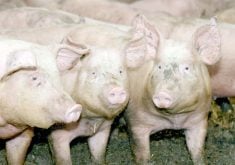NASHVILLE, Tenn. – Better times are expected for the American beef industry this year.
But if the western half of the continent stays dry as predicted, volatility for meat and grain prices is likely.
The 2002 corn crop was smaller than anticipated with a low carryover of 924 million bushels, one of the lowest on record.
“Anything below a billion bushels translates into volatility,” said grain analyst Bill Chandler of Cattlefax. This information was presented to about 1,000 people at the National Cattlemen’s Beef Association convention market session Jan. 30.
Read Also

The Western Producer Livestock Report – October 2, 2025
Western Producer Livestock Report for October 2, 2025. See U.S. & Canadian hog prices, Canadian bison & lamb market data and sale insight.
That volatility could worsen if poor growing conditions lower yields and drive up grain prices.
Ten cents more a bushel on corn raises the break-even price on a finished steer by 75 cents.
More corn acres are anticipated for 2003. If growing conditions are normal, the harvest could be more than 10 billion bu., making it the largest corn crop since 1994.
However, with ending stocks so low, a substantial crop is necessary to meet the needs of the domestic and export markets.
Slow growth in the beef inventory due to drought and high grain prices should start to reverse by 2005, said Dave Webber. Parts of the southeastern United States and Texas should see some herd expansion because weather conditions are more favourable there.
The U.S. Department of Agriculture Jan. 1 cattle inventory survey showed the seventh consecutive year of contraction.
Since the Jan. 1, 1996 peak of 103.5 million head, the American herd has declined to 96.1 million head.
But fewer heifers are being sold for beef this year, so within 30 months beef cow inventory numbers should climb.
“That increase will be at the expense of beef production as we pull those heifers out,” Webber said.
The U.S. is already noting a reduced slaughter level even though there was record beef production of 27.1 billion pounds last year because of overweight carcasses. The average was 758 lb. He anticipates beef production should fall by one billion lb. this year.
Packers are now turning out 490 million lb. a week. Last summer they produced 550 million lb. per week and stockpiles of meat and slaughter-ready cattle backed up the system, driving down cash bids.
Despite setbacks from reduced exports and terrorist fears, 2002 beef consumption was up slightly at 67.5 lb. per capita. There was also record spending.
American consumers spent $210 per capita on beef, up $10 from the year before.
The combination of large supply and higher retail beef prices translated into improved demand. It has been moving upward since 1999. Without that improved demand, live prices could have been 10 cents a lb. lower.
With a reduced cattle and beef supply expected this year, analyst Randy Blach suggested higher prices for all sectors of the industry. But that is only half the equation.
“Higher prices are no guarantee of higher profits.”
Improved prices should salvage the feedlot industry from 18 months of record losses. On average, they are making $25 per finished steer and some are tallying $75-$100. Blach predicted a $12-$15 spread between Choice and Select grades, so those selling on a grid formula should capture a better premium this year.
However, there could also be big price swings if drought continues. There is little feed left on rangelands and producers must make some difficult choices about production plans this spring.

















